-

Win a Free Custom Engraved Brass Coin!!!
As a way to introduce our brass coins to the community, we will raffle off a free coin during the month of August. Follow link ABOVE for instructions for entering.
You are using an out of date browser. It may not display this or other websites correctly.
You should upgrade or use an alternative browser.
You should upgrade or use an alternative browser.
I suspect the ratios of the parts would be similar to those of the English oars. Maybe contact the Musee de la Marine as they are usually very helpful. https://www.musee-marine.fr/nos-musees/paris.html Phone and email are at the bottom of the page. If you are OK with the English ratios, those by Steel should be close. The biggest problem with oars is that the majority seen on models are much too short. The oars are typically 3 to 4 times longer than the breadth of the boat. Note that where the loom is called out as square, but sometimes were oval or round.
Allan
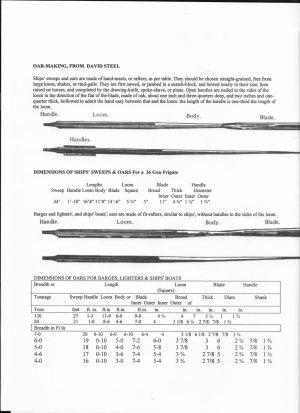
Allan

1. English or French (or anybody else's) it didn't matter: a small boat is/was a small boat.
2. Everyone was stealing everyone else's boats at the drop of a hat. (or at the remnants of the latest battle): If it floated, someone snagged it.
3. Think like the sailors (of all rates and ranks) of the period (basically all liars, cheats and thieves - the bunch). What would you expect from a bunch of short lived illiterates whose only occupation skills were supremely honed for was mass murder? The captains/admirals personalized their gigs to taste no matter how the small boat initially looked anyway. Why should anyone care where the boat originated?
4. The only required criteria was, did it float?
2. Everyone was stealing everyone else's boats at the drop of a hat. (or at the remnants of the latest battle): If it floated, someone snagged it.
3. Think like the sailors (of all rates and ranks) of the period (basically all liars, cheats and thieves - the bunch). What would you expect from a bunch of short lived illiterates whose only occupation skills were supremely honed for was mass murder? The captains/admirals personalized their gigs to taste no matter how the small boat initially looked anyway. Why should anyone care where the boat originated?
4. The only required criteria was, did it float?
To figure out the proper size of sweeps and oars we need to know the dimensions of the boat and how it was set up for rowing. The terms "sweep" and "oar" tend to be used interchangeably but usually oars are shorter and used in pairs while sweeps are larger and each one is used by one or more rowers. Boats can be set up single-banked like a New England whaleboat (this photo was taken at Mystic Seaport Museum). This type of boat was carried on whaleships for hunting whales. New Englanders called these wood things oars but a good case could be made that they could be called sweeps. You can see the rowers sit on the opposite side of the boat from the rowlocks, which gives them good leverage. The lengths of the oars varied with the beam at the rower's station. The foremost oar (harpooner) was typically 13 to 15 feet. The next aft (bow oar) was 15 to 16 feet. The midship oar was 16 to 18 feet. The tub oar (this is location of the tub of line to be attached to the harpoon) was 15 or 16 feet. The after oar was 13 to 15 feet. The fellow with the steering sweep at the stern is called the boatsteerer. The steering oar was 19 to 23 feet.
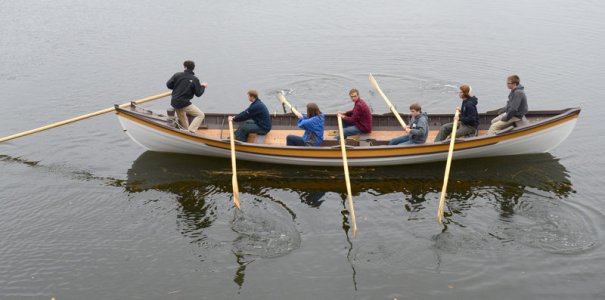
Then here is an example of double-banked rowing. The US Coast Guard and US Navy call these whaleboats but the type was never used for hunting whales. Sweeps or oars? Who knows? They are surely shorter than the wood things on a New England whaleboat.
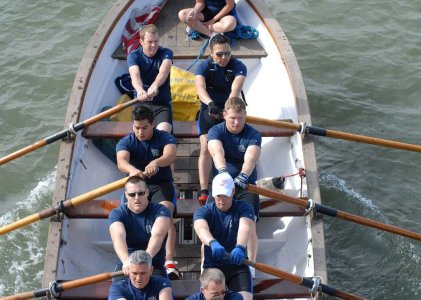
And here is an example of double-banked rowing on a smaller craft. On this Thames skiff the wood things are called oars since each rowers is using two. The person at the stern with the lines to the rudder yoke is the coxswain.
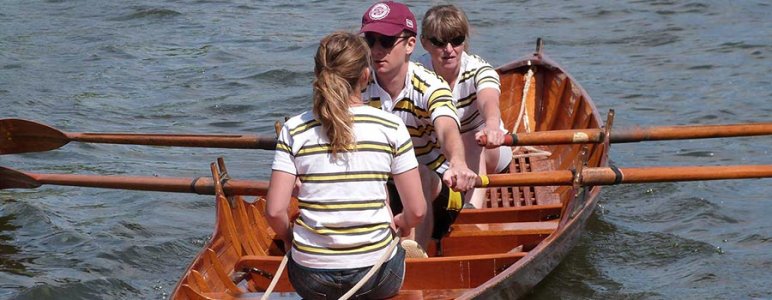
Lastly, some model oars. These are large scale, 1:12 and 1:8.
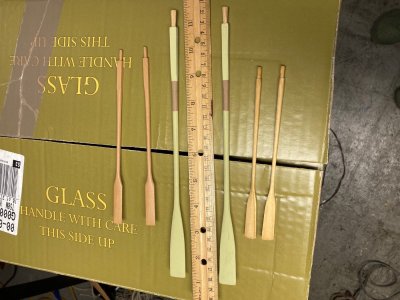
Fair winds to all!

Then here is an example of double-banked rowing. The US Coast Guard and US Navy call these whaleboats but the type was never used for hunting whales. Sweeps or oars? Who knows? They are surely shorter than the wood things on a New England whaleboat.

And here is an example of double-banked rowing on a smaller craft. On this Thames skiff the wood things are called oars since each rowers is using two. The person at the stern with the lines to the rudder yoke is the coxswain.

Lastly, some model oars. These are large scale, 1:12 and 1:8.

Fair winds to all!
- Joined
- Jun 29, 2024
- Messages
- 1,283
- Points
- 393

These rowing setups are like gears in a car. The one above where there is one rower to a seat is like “low gear”. By sitting on the opposite side of the boat from the oarlock, the oarsman gains leverage. With the double banked arrangement each rower has less leverage but there’s more total energy.
A longboat hauling a heavy load would likely place rowers where they had the most mechanical advantage.
Roger
A longboat hauling a heavy load would likely place rowers where they had the most mechanical advantage.
Roger




